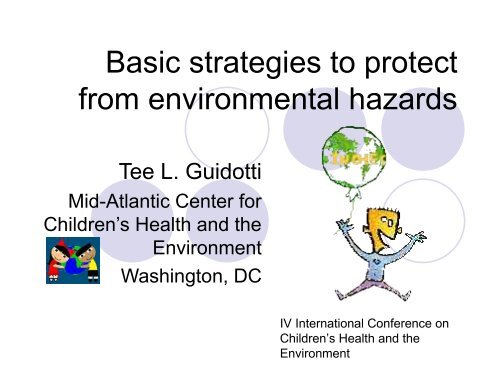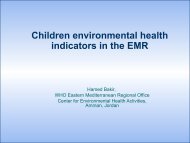Basic strategies to protect from environmental hazards - Inches
Basic strategies to protect from environmental hazards - Inches
Basic strategies to protect from environmental hazards - Inches
Create successful ePaper yourself
Turn your PDF publications into a flip-book with our unique Google optimized e-Paper software.
<strong>Basic</strong> <strong>strategies</strong> <strong>to</strong> <strong>protect</strong><br />
<strong>from</strong> <strong>environmental</strong> <strong>hazards</strong><br />
Tee L. Guidotti<br />
Mid-Atlantic Center for<br />
Children’s Health and the<br />
Environment<br />
Washing<strong>to</strong>n, DC<br />
IV International Conference on<br />
Children’s Health and the<br />
Environment
What are we preventing<br />
Spectrum of<br />
outcomes:<br />
short-term efffects<br />
(“poisoning”)<br />
subclinical effects<br />
contribution of hazard<br />
as risk fac<strong>to</strong>r for<br />
multifac<strong>to</strong>ral disease<br />
In the case of<br />
neurodevelopmental<br />
effects, later and<br />
adult behaviors that<br />
place person at risk<br />
Schema of the Adverse Childhood<br />
Experiences Study:<br />
www.acestudy.org/aboutacestudy.php
Modes of Prevention<br />
Primary prevention<br />
Of disease state<br />
Elimination of exposure, modification of host<br />
susceptibility, interruption of transmission<br />
Secondary prevention<br />
Of disease progression<br />
Early detection and intervention while disorder can be<br />
corrected<br />
Tertiary<br />
Of disability<br />
Medical or rehabilitation intervention <strong>to</strong> improve<br />
outcome
Strategies <strong>to</strong> achieve prevention<br />
Operationalizing prevention<br />
Three basic <strong>strategies</strong>:<br />
Individual child <strong>protect</strong>ion<br />
Preventive medicine model<br />
Public health model
Individual child <strong>protect</strong>ion<br />
Social strategy is parent education<br />
Moni<strong>to</strong>r their activities<br />
Create a safe environment<br />
Educate parents<br />
Mobilize social institutions<br />
Medical moni<strong>to</strong>ring<br />
Instill sense of responsibility<br />
Surrounding the child with a<br />
“cocoon” of safety<br />
Primary prevention strategy<br />
State intervenes only when failure<br />
E<strong>to</strong>bicoke<br />
(Canada) Brighter<br />
Futures Coalition
Rose’s paradigms for collective action<br />
The public health and<br />
preventive medicine<br />
models were first defined<br />
by the late Geoffrey A.<br />
Rose, of the London<br />
School of Hygiene and<br />
Tropical Medicine. They<br />
have been articulated in his<br />
many books and papers.<br />
See: Rose G. The Strategy of<br />
Preventive Medicine.<br />
Oxford, 1992.
Preventive medicine (high risk) paradigm<br />
Applies when there is a known, defined group at<br />
high risk for an adverse outcome<br />
Screen for markers of risk (e.g. blood lead)<br />
Intervene only in those individuals who are at<br />
high risk<br />
If marker is early in process of causation and risk is<br />
reversible, primary prevention is possible<br />
If not, secondary prevention is practical objective<br />
Useful only when there is a practical intervention<br />
State intervention for compliance<br />
Requires intact clinical healthcare system
Example: Lead<br />
Blood lead screening<br />
Identifies children at risk<br />
Targeted intervention<br />
Subclinical damage has already<br />
occurred!<br />
Secondary prevention<br />
Medical intervention for high<br />
elevated BLL is tertiary prevention<br />
Housing should be screened!<br />
Lead paint driving fac<strong>to</strong>r<br />
Obstacle is private property rights<br />
Movement growing <strong>to</strong> change this<br />
http://leadconnections.org/images/LeadScree<br />
ningInfo.jpg
CDC Level of Concern<br />
This is theory behind “Level of<br />
Concern”<br />
Concept now questionable<br />
because demonstrated effects<br />
at lower levels<br />
Controversy over change <strong>to</strong><br />
recommendation<br />
No obvious intervention at this or<br />
lower levels<br />
Would revising level drive<br />
reduction in exposure levels
Public health strategy<br />
Applies when risk is present <strong>to</strong> some degree<br />
among all members or population<br />
Reduce risk for all members of the population,<br />
regardless of risk status<br />
Biggest gains in reduced risk will be seen in higher risk<br />
groups, of course<br />
Gains across all risk groups<br />
Cross-sec<strong>to</strong>ral, many different sources<br />
Requires concerted effort, programming, often<br />
state intervention<br />
Competing health priorities<br />
Attributable risks may be unknown<br />
Program priorities among different outcomes, needs
Example: Lead<br />
Better fits “no threshold”<br />
concept of <strong>to</strong>xicity<br />
Moni<strong>to</strong>r by mean BLL<br />
All-source reduction<br />
Track by geometric mean<br />
in population<br />
Prevents subclinical<br />
damage and contribution<br />
<strong>to</strong> multifac<strong>to</strong>ral outcomes<br />
How <strong>to</strong> do so<br />
Regulation, manufacturing<br />
standards, education, etc.<br />
How <strong>to</strong> allocate<br />
resources
Limitations of the <strong>strategies</strong><br />
The different prevention <strong>strategies</strong> achieve<br />
different goals for lead<br />
All require screening, moni<strong>to</strong>ring<br />
Individual child<br />
<strong>protect</strong>ion<br />
Preventive<br />
medicine<br />
Public health<br />
All risks<br />
(individual)<br />
Frequency of<br />
“poisonings”<br />
(individual)<br />
Prevention of <strong>to</strong>xicity<br />
(population)<br />
Often unreliable<br />
Secondary<br />
prevention<br />
Sustainability
Summary<br />
Three ways <strong>to</strong> <strong>protect</strong> children are not<br />
equally effective applied <strong>to</strong> lead hazard<br />
Individual <strong>protect</strong>ion by parents can fall short<br />
Preventive medicine (“high risk”) paradigm<br />
works best <strong>to</strong> prevent clinical/subclinical<br />
poisoning and otherwise serves children poorly<br />
Public health paradigm is primary prevention<br />
Screening remains important <strong>to</strong> moni<strong>to</strong>r<br />
progress




